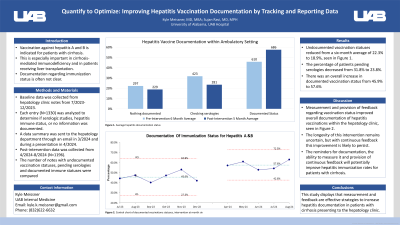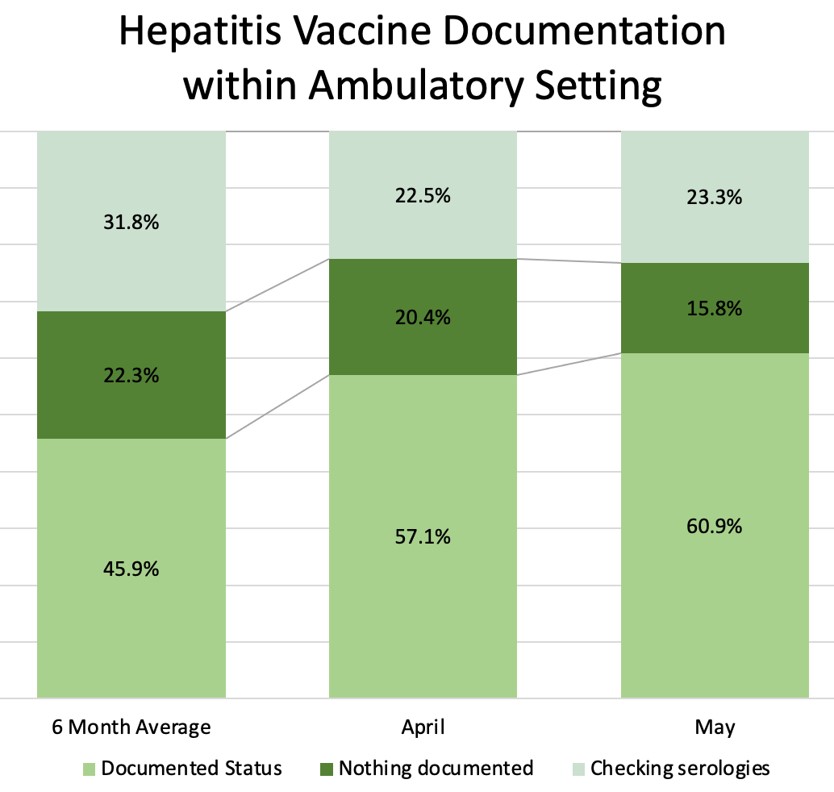Monday Poster Session
Category: Liver
P2904 - Quantify to Optimize: Improving Hepatitis Vaccination Documentation by Tracking and Reporting Data
Monday, October 28, 2024
10:30 AM - 4:00 PM ET
Location: Exhibit Hall E

Has Audio

Kyle K. Meissner, MD, MBA
University of Alabama at Birmingham
Birmingham, AL
Presenting Author(s)
Kyle Meissner, MD, MBA1, Sujan Ravi, MD, MPH2
1University of Alabama at Birmingham, Birmingham, AL; 2University of Alabama at Birmingham Heersink School of Medicine, Birmingham, AL
Introduction: Vaccination against hepatitis A and B is indicated for patients with cirrhosis and is endorsed in all major society guidelines. This becomes especially important in cirrhosis-mediated immunodeficiency and in patients receiving liver transplantation. Documentation regarding immunization status is often not clear. We designed a project to measure accurate vaccine status documentation and offer providers feedback.
Methods: Baseline data was collected from hepatology ambulatory clinics for 6 months from July to December 2023, utilizing a provider template embedded within clinic notes. This template details a patient’s serologic status and vaccination plan. Each entry (N=1330) was analyzed to determine if serologic studies, hepatitis immune status, or no information was documented. This information was presented to the hepatology department through an email in March 2024 and mentioned during a quality improvement discussion in April 2024. Post-intervention data was collected for 2 months after providing feedback to providers (N=490). The percentage of notes with undocumented vaccination statuses, pending serologic studies and partial or complete immune statuses were compared pre and post intervention.
Results: Two months following intervention, the percentage of undocumented vaccinations statuses reduced from a six-month average of 22.3% to 15.8%. The percentage of patients pending serologies decreased from 31.8% to 22.5% and 23.3% in April and May. These changes resulted in an overall increase in documented vaccination status from 45.9% to 60.9%, shown in Figure 1.
Discussion: Measurement and provision of feedback regarding vaccination status improved overall documentation of hepatitis vaccinations within the hepatology clinic. While the longevity of this intervention remains uncertain, with continuous feedback this improvement is likely to persist. The reminders for documentation built into the template, the ability to measure it and provision of continuous feedback will potentially improve hepatitis immunization rates for patients with cirrhosis.

Disclosures:
Kyle Meissner, MD, MBA1, Sujan Ravi, MD, MPH2. P2904 - Quantify to Optimize: Improving Hepatitis Vaccination Documentation by Tracking and Reporting Data, ACG 2024 Annual Scientific Meeting Abstracts. Philadelphia, PA: American College of Gastroenterology.
1University of Alabama at Birmingham, Birmingham, AL; 2University of Alabama at Birmingham Heersink School of Medicine, Birmingham, AL
Introduction: Vaccination against hepatitis A and B is indicated for patients with cirrhosis and is endorsed in all major society guidelines. This becomes especially important in cirrhosis-mediated immunodeficiency and in patients receiving liver transplantation. Documentation regarding immunization status is often not clear. We designed a project to measure accurate vaccine status documentation and offer providers feedback.
Methods: Baseline data was collected from hepatology ambulatory clinics for 6 months from July to December 2023, utilizing a provider template embedded within clinic notes. This template details a patient’s serologic status and vaccination plan. Each entry (N=1330) was analyzed to determine if serologic studies, hepatitis immune status, or no information was documented. This information was presented to the hepatology department through an email in March 2024 and mentioned during a quality improvement discussion in April 2024. Post-intervention data was collected for 2 months after providing feedback to providers (N=490). The percentage of notes with undocumented vaccination statuses, pending serologic studies and partial or complete immune statuses were compared pre and post intervention.
Results: Two months following intervention, the percentage of undocumented vaccinations statuses reduced from a six-month average of 22.3% to 15.8%. The percentage of patients pending serologies decreased from 31.8% to 22.5% and 23.3% in April and May. These changes resulted in an overall increase in documented vaccination status from 45.9% to 60.9%, shown in Figure 1.
Discussion: Measurement and provision of feedback regarding vaccination status improved overall documentation of hepatitis vaccinations within the hepatology clinic. While the longevity of this intervention remains uncertain, with continuous feedback this improvement is likely to persist. The reminders for documentation built into the template, the ability to measure it and provision of continuous feedback will potentially improve hepatitis immunization rates for patients with cirrhosis.

Figure: Figure 1. Hepatitis Documentation Rates
Disclosures:
Kyle Meissner indicated no relevant financial relationships.
Sujan Ravi indicated no relevant financial relationships.
Kyle Meissner, MD, MBA1, Sujan Ravi, MD, MPH2. P2904 - Quantify to Optimize: Improving Hepatitis Vaccination Documentation by Tracking and Reporting Data, ACG 2024 Annual Scientific Meeting Abstracts. Philadelphia, PA: American College of Gastroenterology.
